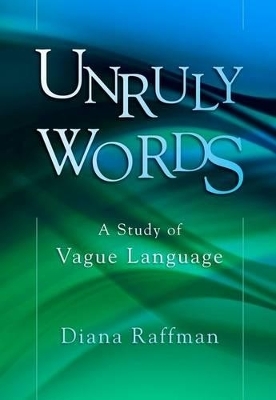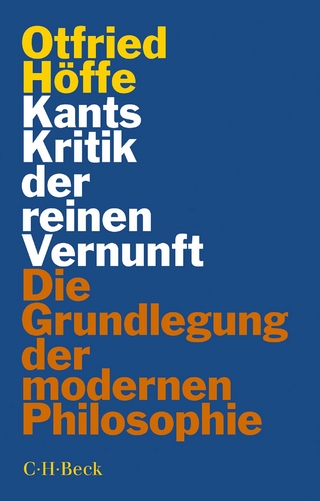
Unruly Words
Oxford University Press Inc (Verlag)
978-0-19-991510-1 (ISBN)
Vague words, like "tall," "rich," and "old," lack clear boundaries of application: no clear line divides the tall people from the above average, or the old people from the middle-aged. Because they lack clear boundaries, these ordinary words cause logical and semantic problems in various disciplines including philosophy, decision theory, and the law. Philosophers and linguists have proposed several theories of vagueness to handle these difficulties, but none has been widely accepted.
Raffman contends that virtually all previous treatments of vagueness have made two crucial mistakes: they have supposed that a semantic (non-epistemic) theory must abandon bivalence, and they have paid insufficient attention to the character of ordinary speech using vague words. She develops a new theory of vagueness-the multiple range theory-that corrects both of these errors. The new theory begins with the observation that ordinary speakers seem to apply vague words in multiple arbitrarily different but equally competent ways, even when all contextual factors are held fixed. Raffman interprets this feature of their use as evidence of multiple ranges of application in the semantics of vague words, where a range of application is a range of properties whose instances satisfy the word in question; for example, a range of application of "tall" is a range of heights, a range of "old" a range of ages, and so forth. The fundamental idea is that a vague word has multiple ranges of application, and applies to things relative to those ranges, even given a single fixed context. The fact that the ranges of a vague word are arbitrarily different-there is no reason to favor any particular one-is key to solving the notorious sorites paradox.
The multiple range theory preserves bivalence and is more intuitive than other approaches. It is also simpler; for instance, it has no need of a definiteness operator, and it rules out the possibility of higher-order borderline cases, both of which introduce severe complications into other accounts. Some of the evidence Raffman draws upon in constructing her theory comes from a new psychological study of the way ordinary speakers actually use vague words.
Diana Raffman is a professor of philosophy at the University of Toronto. She has published a number of papers in the philosophy of mind, primarily about consciousness and perception, in the philosophy of language, primarily about vagueness, and in the philosophy of art, primarily about music. She is currently writing a series of papers about the role of vagueness in legal language.
Preface ; 1. Introduction and Fundamentals ; 1.1. Whirlwind Tour of Competing Theories of Vagueness ; 1.2. Initial Observations (1): Blurred Boundaries, Sharp Boundaries, and Stopping Places ; 1.3. Initial Observations (2): Vagueness and Gradability ; 1.4. Initial Observations (3): Vagueness and Soriticality ; 1.5. Initial Observations (4): Vagueness and Context-Sensitivity ; 1.6. Vagueness and Rule-following ; 1.7. Two Policies and a Caveat ; 1.8. Selective Review ; 1.9. Looking Ahead ; 2. The In's and Out's of Borderline Cases ; 2.1. Lay of the Land ; 2.2. The Standard Analysis ; 2.3. The Incompatibilist Analysis ; 2.4. Objections and Replies ; 2.5. Symmetry, Indeterminacy, Higher-Order Borderlines, Accessibility; and Some Advantages of the Incompatibilist Analysis ; 2.6. Independently Fishy Features of Higher-Order Borderlines ; 2.7. Selective Review ; 2.8. Looking ahead. ; 3. Framework for a Semantics of Vagueness ; 3.1. Vagueness and Indexicality ; 3.2. Two Ingredients of Sense for Vague Words ; 3.3. A Refinement: Contexts of Utterance vs Intended Contexts ; 3.4. Selective Review ; 3.5. Looking Ahead ; 4. The Multiple Range Theory of Vagueness ; 4.1. Vagueness and Reference ; 4.2. Why Ranges of Application Are Not Precisifications ; 4.3. Progress Report and Two Criteria of Vagueness ; 4.4. Evaluation ; 4.5. Solving the Sorites ; 4.6. Verdicts on Some Specific Predicates ; 4.7. Vagueness, Soriticality, Borderlines, V-index-sensitivity, Gradability, ; and Indeterminacy: Relatives or Just Friends? ; 4.8. Selective Review ; 4.9. Looking Ahead ; Figures ; 5. The Competent Use of Vague Words ; 5.1. A Pragmatic Sorites ; 5.2. Testing for Hysteresis ; 5.3. Non-perceptual Hysteresis: Does Our Hypothesis Generalize? ; 5.4. Meaning and Use: Implementing the Multi-Range Semantics ; 5.5. An Etymological Speculation ; 5.6. The Truth About Tolerance ; 5.7. Looking Back: Rules, Reasons, and the Governing View ; Figures ; Appendix ; Notes ; Bibliography ; Index
| Verlagsort | New York |
|---|---|
| Sprache | englisch |
| Maße | 219 x 147 mm |
| Gewicht | 395 g |
| Themenwelt | Geisteswissenschaften ► Philosophie ► Erkenntnistheorie / Wissenschaftstheorie |
| Geisteswissenschaften ► Philosophie ► Logik | |
| Geisteswissenschaften ► Philosophie ► Sprachphilosophie | |
| Geisteswissenschaften ► Sprach- / Literaturwissenschaft ► Sprachwissenschaft | |
| ISBN-10 | 0-19-991510-5 / 0199915105 |
| ISBN-13 | 978-0-19-991510-1 / 9780199915101 |
| Zustand | Neuware |
| Haben Sie eine Frage zum Produkt? |
aus dem Bereich


![Was heißt Denken?. Vorlesung Wintersemester 1951/52. [Was bedeutet das alles?] - Martin Heidegger](/media/113619842)